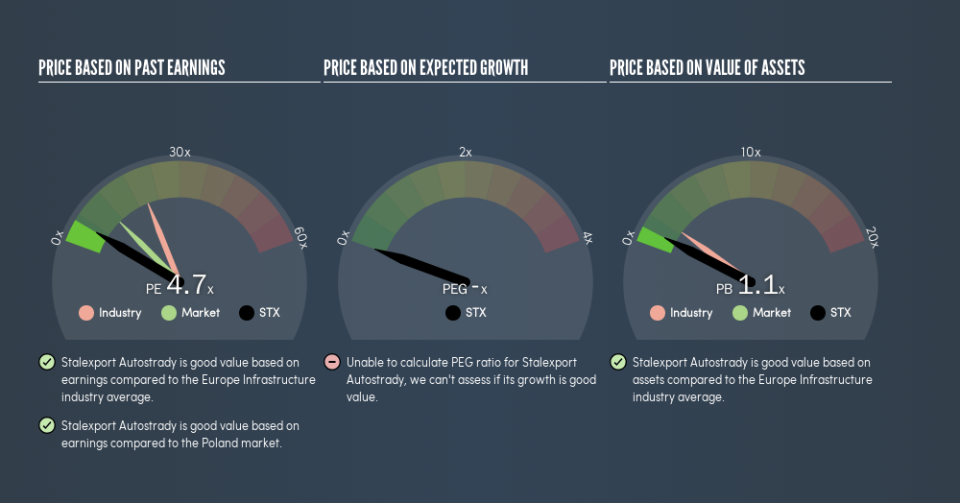Read This Before You Buy Stalexport Autostrady S.A. (WSE:STX) Because Of Its P/E Ratio

Want to participate in a short research study? Help shape the future of investing tools and you could win a $250 gift card!
This article is written for those who want to get better at using price to earnings ratios (P/E ratios). To keep it practical, we'll show how Stalexport Autostrady S.A.'s (WSE:STX) P/E ratio could help you assess the value on offer. Looking at earnings over the last twelve months, Stalexport Autostrady has a P/E ratio of 4.67. In other words, at today's prices, investors are paying PLN4.67 for every PLN1 in prior year profit.
See our latest analysis for Stalexport Autostrady
How Do I Calculate A Price To Earnings Ratio?
The formula for price to earnings is:
Price to Earnings Ratio = Price per Share ÷ Earnings per Share (EPS)
Or for Stalexport Autostrady:
P/E of 4.67 = PLN3.42 ÷ PLN0.73 (Based on the trailing twelve months to December 2018.)
Is A High Price-to-Earnings Ratio Good?
A higher P/E ratio means that buyers have to pay a higher price for each PLN1 the company has earned over the last year. That is not a good or a bad thing per se, but a high P/E does imply buyers are optimistic about the future.
How Growth Rates Impact P/E Ratios
Earnings growth rates have a big influence on P/E ratios. When earnings grow, the 'E' increases, over time. That means even if the current P/E is high, it will reduce over time if the share price stays flat. And as that P/E ratio drops, the company will look cheap, unless its share price increases.
Stalexport Autostrady increased earnings per share by an impressive 18% over the last twelve months. And it has bolstered its earnings per share by 25% per year over the last five years. With that performance, you might expect an above average P/E ratio.
Does Stalexport Autostrady Have A Relatively High Or Low P/E For Its Industry?
The P/E ratio indicates whether the market has higher or lower expectations of a company. If you look at the image below, you can see Stalexport Autostrady has a lower P/E than the average (21.3) in the infrastructure industry classification.
Its relatively low P/E ratio indicates that Stalexport Autostrady shareholders think it will struggle to do as well as other companies in its industry classification. Since the market seems unimpressed with Stalexport Autostrady, it's quite possible it could surprise on the upside. If you consider the stock interesting, further research is recommended. For example, I often monitor director buying and selling.
Remember: P/E Ratios Don't Consider The Balance Sheet
It's important to note that the P/E ratio considers the market capitalization, not the enterprise value. In other words, it does not consider any debt or cash that the company may have on the balance sheet. In theory, a company can lower its future P/E ratio by using cash or debt to invest in growth.
Such spending might be good or bad, overall, but the key point here is that you need to look at debt to understand the P/E ratio in context.
Stalexport Autostrady's Balance Sheet
Stalexport Autostrady has net cash of zł254m. This is fairly high at 30% of its market capitalization. That might mean balance sheet strength is important to the business, but should also help push the P/E a bit higher than it would otherwise be.
The Verdict On Stalexport Autostrady's P/E Ratio
Stalexport Autostrady has a P/E of 4.7. That's below the average in the PL market, which is 10.7. The net cash position gives plenty of options to the business, and the recent improvement in EPS is good to see. One might conclude that the market is a bit pessimistic, given the low P/E ratio.
Investors have an opportunity when market expectations about a stock are wrong. If it is underestimating a company, investors can make money by buying and holding the shares until the market corrects itself. So this free visualization of the analyst consensus on future earnings could help you make the right decision about whether to buy, sell, or hold.
Of course, you might find a fantastic investment by looking at a few good candidates. So take a peek at this free list of companies with modest (or no) debt, trading on a P/E below 20.
We aim to bring you long-term focused research analysis driven by fundamental data. Note that our analysis may not factor in the latest price-sensitive company announcements or qualitative material.
If you spot an error that warrants correction, please contact the editor at editorial-team@simplywallst.com. This article by Simply Wall St is general in nature. It does not constitute a recommendation to buy or sell any stock, and does not take account of your objectives, or your financial situation. Simply Wall St has no position in the stocks mentioned. Thank you for reading.

 Yahoo Finance
Yahoo Finance 
